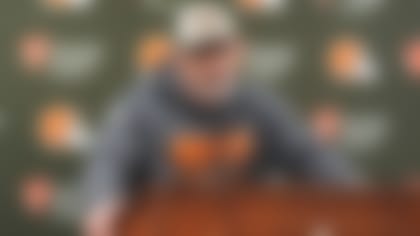After months and months of build-up, the NFL draft hits football fans like a shot of adrenaline. Over the span of three days, we ingest 250-plus selections, numerous trades and a whole heap o' hot takes. In such a frenzied environment with action involving all 32 teams, it can be hard to determine which organizations are really maximizing their draft capital.
In an attempt to quantify the impact of each draft pick, I've turned to a model I developed that projects future player performance in the context of the franchise they ended up with. This means mapping out their production according to team personnel, coaching philosophies and opponents faced. For a more in-depth explanation on the mechanics of my model, click here.
Per my model, these are the five best values from Round 1 of the 2019 NFL Draft, weighing the players' projected output against where they were selected:
1) Dwayne Haskins, QB, Washington Redskins
Drafted No. 15 overall.
Despite having an obvious need at the most important position in the game, the Redskins were able to get the exact quarterback they were targeting without having to give up any trade equity. Last season, the Redskins only threw 16 total passing touchdowns (T-28th in the league) and only averaged 188.8 passing yards per game (also T-28th).
As for Haskins, the one-year starter from Ohio State is my highest-ranked player at the position in this draft and third in my overall rankings. One area that helps drive this? His production against the blitz. Last season, teams tested his mobility using the blitz and Haskins, in turn, carved them up. He threw 22 touchdowns to only two interceptions while only seeing a small decrease in completion percentage when blitzed (72.3 percent from a clean pocket, 65.2 percent when facing the blitz), according to Pro Football Focus. Despite the small on-field sample size that includes an outlier number of touchdowns (50!) last season, there are some clues about what the Redskins are getting in Haskins. One place where the quarterback's predictive indicators are strong? Finishing games. In the fourth quarter last season, he threw 14 touchdowns and only one interception, and his production increased at the end of the season.
Washington had 24 players on injured reserve last season, including seven offensive linemen. In other words, the Redskins were beyond banged up. When healthy, though, Washington's offensive line ranks among the top five units in the league, which will help shorten Haskins' learning curve.
2) Jeffery Simmons, DT, Tennessee Titans
Drafted No. 19 overall.
My model ranked the Mississippi State defensive tackle as the seventh-best player in this entire draft class. The Titans' current roster (they now have six defensive tackles) allowed them the luxury to draft the talented Simmons, who suffered an ACL injury in February, and while his injury creates an uncertain timeline for his return to the field, Tennessee realizes the upside he can provide. Per PFF, Simmons recorded 36 tackles for loss or no gain since 2016 (most among SEC defensive linemen) and 34 quarterback pressures last season alone (fourth among SEC interior linemen).
The team's offseason additions, especially at guard (Rodger Saffold) and defensive end (Cameron Wake), also helped create the flexibility to be able to draft Simmons in this spot.
3) Deandre Baker, CB, New York Giants
Drafted No. 30 overall.
Ahead of the draft, the Georgia cornerback was my 13th-ranked player overall. Addressing a huge team need, even though the Giants had to use draft equity (Nos. 37, 132 and 142 in 2019) to trade back up into the first round, provides exceptional value with this pick.
On third down last season, the Giants allowed the league's second-worst completion percentage (68.9), gave up 6.1 yards per play (13th in the NFL) with a 104.1 passer rating allowed (26th) and only one takeaway. That's where Baker comes in. Over the past two seasons at Georgia, he allowed a 41.8 completion percentage in coverage (third lowest in FBS, per PFF) and only 4.6 yards per target in coverage (second lowest in FBS). He also forced an incompletion on 28.2 percent of his targets over this span (second-highest in FBS). Adding even more context, the quality of offenses Baker faced and the diversity of offensive formations elevates his resume even more.
4) Jonah Williams, OT, Cincinnati Bengals
Drafted No. 11 overall.
I spend more time than I'd care to admit analyzing O-linemen. Actually who am I kidding, I talk and write about it almost daily. The Alabama product was not only my highest-rated offensive lineman, but he ranked fifth overall in my model. There were some questions before the draft about whether teams viewed Williams as a guard or tackle. To me, and especially now as a Bengal, Williams is a tackle. On average, NFL teams suit seven linemen on game day. This means that adding versatility, especially with a talent like Williams, can be a big benefit. The Bengals could use it. Last season, Cincinnati's offense ranked 21st in rushing (105.1 yards per game) and 24th in passing (205.6 ypg). My model, which includes computer vision metrics, rates the Bengals' O-line 26th in the league as a unit last season.
Last season at Alabama, PFF notes that Williams did not allow a sack on 466 pass-blocking snaps (fifth-best in the FBS). Using my model on his game film, computer vision shows that his pressure rate was in the top 10 percent of the entire 10-season FBS sample. This should make Andy Dalton happy, especially when factoring in the level of competition he faced.
5) Josh Allen, Edge, Jacksonville Jaguars
Drafted No. 7 overall.
I realize seven is a very high draft pick, but I had Allen ranked as my No. 2 overall player -- and those are five pricey picks. The Jaguars, therefore, got great value after the Giants -- who also have a need at edge rusher -- chose quarterback Daniel Jones with the sixth overall pick.
I can give additional context showing how the Jags' defense didn't perform as well in 2018 (when the team went 5-11) as they did in 2017 (10-6 that season), and how their sack total (falling to 37 from 55) and takeaways (17 from 33) reduced, but more important is that they still had a top 10 overall defense according to my metrics that use contextual, situational stats and computer vision. Adding Allen to that unit adds even more aggressiveness to this defensive front.
At Kentucky, Allen became the only FBS player to earn 150-plus tackles, 20-plus sacks and 30-plus tackles for loss over the past two seasons (he had 24 sacks and 32 tackles for loss). His 11 forced fumbles over the past three seasons are also tied for most in FBS during that span. PFF counted 57 pressures for Allen last season, which paced the SEC, and attributed 24 quarterback hits to him over the past two seasons (also most in the SEC).
Want one more thing? I added all the Round 1 picks to their respective teams tonight. Can you guess the likelihood of Allen having seven or more sacks as a Jag? 63.5 percent! Sidebar: This is also good news for Calais Campbell's sack projection.
Follow Cynthia Frelund on Twitter @cfrelund.












